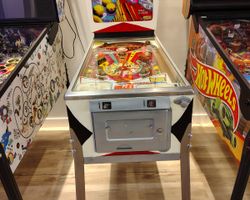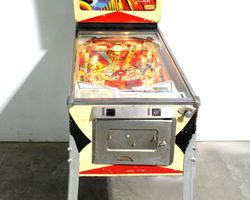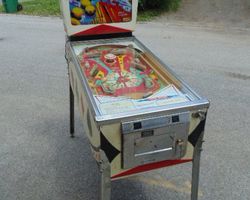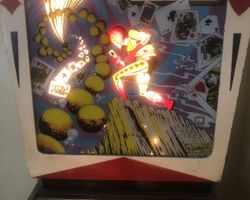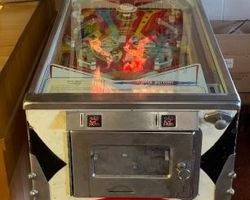High Hand
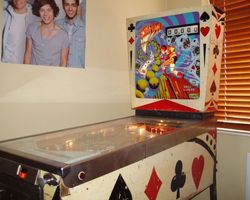
Average Prices: USD $400 to $1,300
Produced: July, 1973
Production Run: 4,950 units
Machine Type: Electro-mechanical
Players: 1
Design by: Ed Krynski
Art by: Gordon Morison
High Hand, a pinball machine released by D. Gottlieb & Co. in July 1973, stands as a distinctive example of the electro-mechanical (EM) era. Designed by Ed Krynski with artwork by Gordon Morison, this single-player game emerged during a period when pinball machines relied on intricate mechanical assemblies and electromechanical relays rather than circuit boards and digital displays. Its creation followed Gottlieb's established pattern of producing visually appealing and mechanically engaging machines. With a production run of 4,950 units, High Hand solidified its presence in the market, becoming a staple in arcades and amusement locations of the early 1970s. The machine's theme revolves around playing cards, presented with a vibrant, almost psychedelic aesthetic that gives it a unique visual identity. Interestingly, High Hand served as the foundation for other Gottlieb titles; its add-a-ball counterpart, "Captain Card," was released the following year, while an Italian version, "Top Hand," also debuted in 1973, showcasing the adaptable nature of Gottlieb's designs.
Signature Features and Design
Central to High Hand's appeal and design philosophy are its numerous drop targets, a defining feature that sets it apart. The machine boasts a remarkable 16 drop targets, strategically arranged in four banks across the playfield. These targets are not merely static obstacles; they are integral to the game’s scoring and progression, offering a primary objective for players. Beyond the mechanical elements, the machine’s artistic presentation contributes significantly to its identity. The backglass artwork is particularly notable, widely regarded for its stunning, eye-catching, and vibrant depiction of a space-themed poker game. This visual spectacle draws players in, setting a tone of playful challenge before the first ball is plunged. The playfield artwork, while distinct from the backglass, complements the overall theme with its bright colors and card-inspired motifs, ensuring visual cohesion. Accompanying the mechanical action, High Hand’s sound design relies on classic EM elements: three chimes provide distinct auditory feedback for scoring events and bonuses, while a knocker delivers a satisfying accent for special achievements, immersing the player in the responsive, analog world of 1970s pinball.
Playfield and Mechanics
The High Hand playfield is a study in focused design, centered around precision and target engagement. At its core are the 16 drop targets, arranged in four distinct banks, each comprising four targets. These banks are positioned to offer varied shot angles, challenging players to master banking shots and direct hits alike. The primary objective often involves clearing these targets to light various features. Situated prominently in the middle of the playfield is a kick-out hole, a high-value target that becomes a key focus for players seeking substantial rewards, particularly once the drop targets have been cleared. The playfield also features two flippers at the base, providing the essential means of ball control and shot execution. A single pop bumper, positioned strategically, adds an element of unpredictable bounce, while two slingshots contribute to dynamic ball deflection, keeping the action lively around the lower playfield. A star rollover switch is also present, contributing to scoring or feature progression. A deliberate design choice in High Hand is that the drop targets do not reset during gameplay; once a target is dropped, it remains down for the duration of the ball in play. This mechanic dictates a distinct shift in gameplay as the game progresses and more targets are cleared, influencing the flow and requiring players to adapt their strategies. The mechanical reel display tracks scores up to 99,990 points, maintaining the authentic EM experience, and the manual plunger ensures a direct, tactile launch for each ball.
Gameplay Dynamics
High Hand's gameplay dynamics are defined by its emphasis on target shooting and the unique progression dictated by its non-resetting drop targets. The primary objective is to skillfully hit the 16 drop targets, scoring points and lighting various features. As players clear banks of targets, they progressively unlock higher scoring opportunities and activate specials. A major strategic element revolves around successfully hitting the central kick-out hole, which often lights for significant points or special awards, creating a high-risk, high-reward shot. The game rewards accuracy, demanding precise flipper control to clear the targets, especially those positioned at challenging angles or requiring banking shots off other playfield elements.
The unique challenge arises from the drop targets remaining down once hit. This means that as more targets are cleared, the playfield opens up, and the focus shifts. Once all targets in a bank are down, that bank no longer offers scoring from hits, redirecting player attention to remaining targets or, crucially, to the lit kick-out hole. This design choice prevents repeated target resets and pushes players to adapt their strategy mid-game. Strategies often involve systematically clearing banks, then focusing on the difficult-to-hit kick-out hole, or attempting risky shots to light outlane specials. The bonus system adds another layer of scoring, encouraging players to accumulate bonuses throughout their ball in play, which are then awarded at the end of the ball. The addictive quality of High Hand often comes from the satisfaction of finally clearing a challenging bank of targets or nailing the elusive kick-out hole shot, prompting players to play "just one more game" in pursuit of a higher score or a perfect run.
Reception and Legacy
High Hand has garnered a largely positive reception within the pinball community, particularly among enthusiasts of electro-mechanical machines. Its strengths are frequently cited as its challenging and addictive gameplay. Many players appreciate the demanding nature of hitting all 16 drop targets and the precision required to secure the high-value kick-out hole shots. This difficulty, rather than deterring players, often fosters a desire for "just one more game," driving engagement through the pursuit of mastery. The backglass artwork, with its striking, psychedelic card theme, consistently receives high praise for its visual appeal, often described as a centerpiece that enhances any collection. Furthermore, the machine is noted for its relatively straightforward maintenance, making it an accessible option for those new to EM repair or restoration. Its unique challenge makes it a valued addition to a diverse collection, complementing other machines rather than serving as the sole focus.
However, High Hand is not without its points of contention. The most frequently discussed aspect is the design choice where the 16 drop targets do not reset during gameplay. While some players find this a compelling element that shifts the game’s dynamic and maintains a consistent challenge, others perceive it as a weakness, leading to a feeling of "dead zones" once targets are cleared and limiting the replayability during a single ball. The central kick-out hole, while rewarding, is often described as difficult to hit, sometimes relying more on luck than consistent skill. Some players also note the presence of wide-open areas on the playfield where the ball can roll without significant interaction, and the placement of specials in the outlanes can feel counterintuitive, rewarding a lost ball. Compared to more modern or even faster-paced EM games, High Hand's tempo can be perceived as slower by some. Despite these observations, High Hand’s legacy remains strong as a quintessential Gottlieb EM machine. Its focus on precise target shooting and its distinctive drop target mechanic influence how players approach mechanical pinball, highlighting a period where skill and direct interaction with electromechanical components were paramount. Its enduring appeal lies in its straightforward yet demanding gameplay, solidifying its place as a classic among EM pinball machines.
Sponsored Links
 Ebay Listings
Ebay Listings
 Auction Results
Auction Results
| Cost | Location | Date |
|---|---|---|
| USD $4,000 |  Florida, United States Florida, United States |
06 August, 2025 |
| AUD $1,200 |  New South Wales, Australia New South Wales, Australia |
18 February, 2025 |
| GBP £885 |  United Kingdom United Kingdom |
16 December, 2024 |
| USD $1,250 |  United States United States |
21 May, 2024 |
| GBP £885 |  Ashfield, United Kingdom Ashfield, United Kingdom |
21 March, 2023 |
| USD $700 |  Maryland, United States Maryland, United States |
05 January, 2023 |
| USD $1,500 |  California, United States California, United States |
17 December, 2022 |
| USD $495 |  Indiana, United States Indiana, United States |
28 November, 2022 |
| USD $890 |  Arizona, United States Arizona, United States |
10 October, 2022 |
| AUD $2,500 |  New South Wales, Australia New South Wales, Australia |
16 June, 2022 |


Private Policy · Search Website · Contact Us
As an eBay Partner, we may earn a commission from qualifying purchases made through links on this site, at no additional cost to you.
All trademarks and copyrighted materials remain property of their respective owners. All other content copyright 2007 - 2025 Pinpedia.

